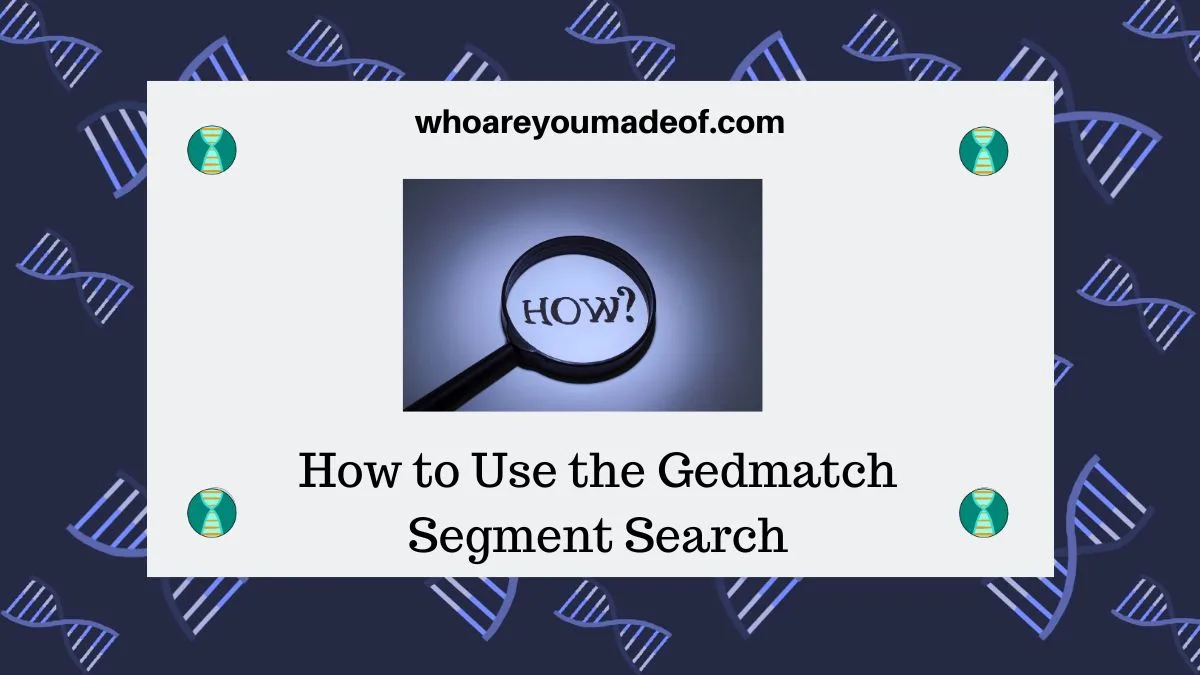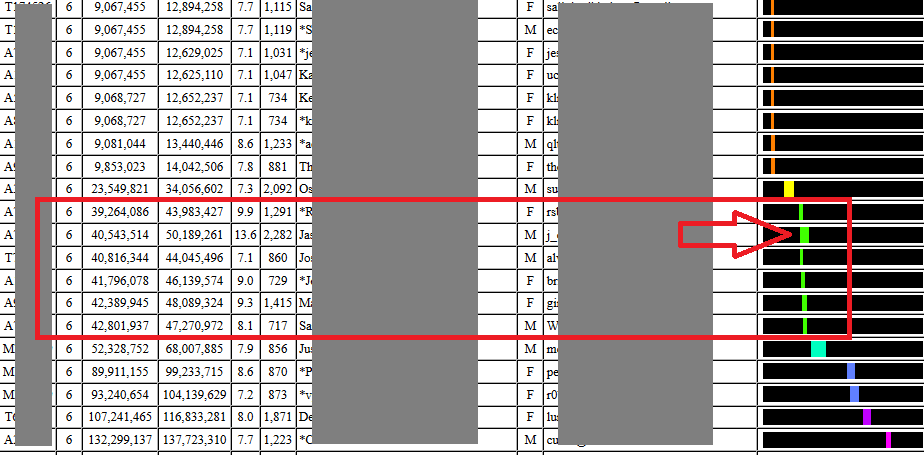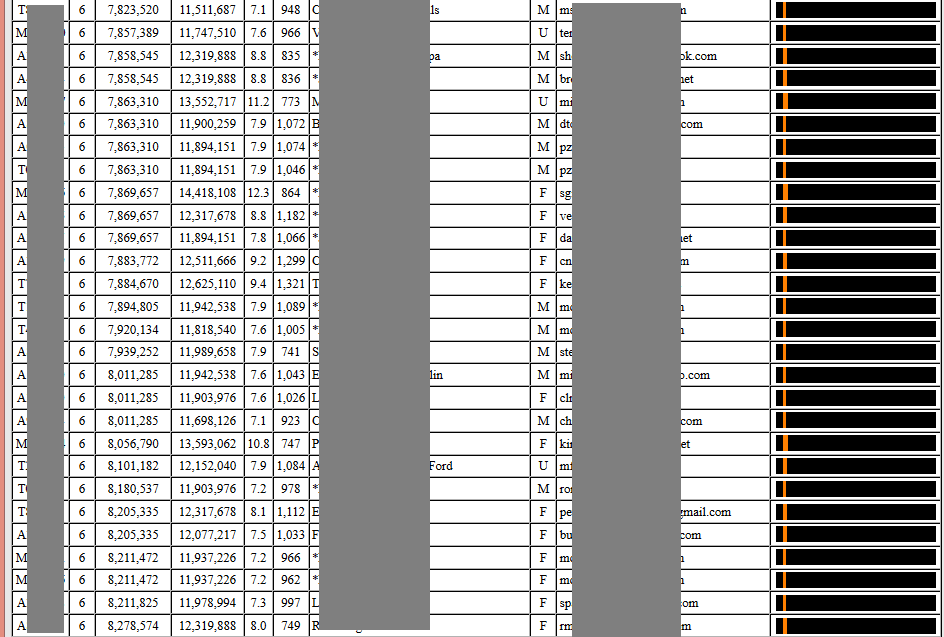Do you want to know how to use the Gedmatch Matching Segment Search tool? Learn how this tool can help you learn more about your DNA and family tree.
Gedmatch, which has a nice selection of free tools for analyzing DNA, also has several "Tier 1 Utilities". In order to access these utilities, you have to pay a $10 monthly access fee - and in the case of the Matching Segment Search tool, it's money well spent.
In this post, you will learn:
- a little bit about chromosomes and DNA inheritance (but we won't get too scientific)
- what the segment matching tool does
- how to use the Gedmatch Matching Segment Search
- a few ways to apply the information that you learn

Chromosomes and DNA inheritance
For most of us, it has been a long, long time since middle school science class. In order to really understand what the Matching Segment Search tool can tell us, we need to cover some basics.
Humans have 23 pairs chromosomes, and in order to make up each pair, we inherit one from each of our parents - for a total of 46 chromosomes. DNA testing companies are able to basically "map" our our chromosomes using their software, and find where other people match us on specific locations on individual chromosomes.
When we get a DNA match, this is how the software knows that we have identical genetic material and reports us as a match to each other.
The locations on our chromosomes where we made other individuals are called "segments", or DNA segments.
We inherited very large segments of DNA from our parents, and contained within those large segments are smaller segments, which came from our grandparents, and yet smaller segments that came from our great-grandparents, and so on, and so on.
DNA segments are measured with a unit of measurement called "centimorgans". This word is usually abbreviated using "cMs". When someone refers to a 45 cM DNA segment, they are referring to the size of the DNA segment, and it means that the segment is 45 centimorgans.
It's important to note that we share DNA with many of our ancestors at the great-great grandparent level and further back, but not all of them. This is why tools like the Matching Segment Search can really help provide information that can help us figure out information about our family history that we otherwise would not be able to access.
What the Matching Segment Search tool does
The Gedmatch Matching Segment Search tool goes sorts through our 3000 or so closest DNA matches on the site and lines them up in order, based on where they match on each chromosome.
We are able to visually see which DNA matches match us on which chromosomes. It's a beautiful sight to see.
While it could theoretically be done manually with a spreadsheet and a few 40-hour weeks, isn't it better to have a machine do the work for you in a matter of minutes?
Seriously, it's the best $10 that I have spent in a while. It saved me weeks and weeks of headaches and research.
The tool tells you the following information about each match:
| Kit | Chr | Start Position | End Position | cM | SNPs | Name | Sex |
(Chr is an abbreviation for chromosome, and cMs for centimorgans, of course)
The results are displayed beginning with your first chromosome, and in order down the list of chromosomes. People who match you on each chromosome will be listed in order based on the exact location of the segment within the chromosome where you match.
Here is a visual of the list (with identifying information blurred out to protect privacy):

If this all looks like a bunch of gibberish, don't worry , I will explain everything to you here so you can understand your own results. I should add that the large blocks of grey are just blocks that I put there to hide the kit numbers, names and e-mail addresses of the DNA matches that showed up.
In your own results, you will be able to see all of this information.
In the image above, it shows all of the people who match my husband (who doesn't mind me talking about his DNA on this site, bless him!) on chromosome 6. The results are neat, because they display the different matching segments.
The orange segments are towards the "beginning" of the chromosome, and you can see to the left in the image that the numbers are lower (the start and stop locations on the segment).
The other interesting thing to note is the thickness of the color segment. The thicker they are, they larger. As an example of this, take a peek at the bright green colors.
All six of those individuals match my husband at overlapping segments on the 6th chromosome. It is statistically probable that all of these matches, along with my husband, inherited this segment from the same person.
Important Note: Since we inherit one copy of each chromosome from each of our parents, we need to know that some of the people who match on one segment could be on our paternal side, and others could be on the maternal side of our family. To account for this, we should phase our matches.
As far as tracing who that person is, the larger the segment the better, since that implies a more recent connection to the common ancestor. I can easily see that the one match in particular is a larger segment - I drew a big red arrow to point to it in the list.
They match at 13.6 cMs, and with a segment this size, it's more likely to be able to find who the common ancestor was. Or is?
Which leads me to the following...
How can the Matching Segment Search tool help you?
While there are probably more applications than I can think of for this article, here are a few ways that the tool can help you in a very concrete way. Using those clusters of people that you see on your results (as show in the image above), you can really start to piece together the information that is held in your DNA.
This idea is similar to "clustering" of DNA matches, such as what we can achieve on Ancestry using custom groups. However, since we don't have access to the actual chromosome-level data on sites like that, we don't actually know for sure that each person in the cluster shares the same DNA segment.
Below, find examples of what you could learn from this tool.
Build your family tree further back
Especially effective with more recent ancestors, you can use the matching segments to compare the trees of your ancestors and break through some of those pesky brick walls (i.e. places where you are stuck on your tree). I am currently in the process of doing this in my mother's tree, and it has proved to be very helpful.
Use the matching segment search to learn about ethnicity regions
You can use the Matching Segment Search tool to help you research your "trace" ethnicity. I show an example of how I am doing this with my husband's DNA towards the end of this article.
Results can be used for chromosome mapping
For the very dedicated, you could begin to "map out" your chromosomes in order to determine which segments you inherited from which lines of your family. This is a great help in immediately identifying which sides of your family new matches are on.
Example of how Matching Segment Search tool can be used to research trace ethnicity
My husband has about 95% Native American DNA, and he has about 4% European ancestry that we believe is Irish.
There are a few different ways that he could have inherited his 4% European ancestry:
- One ancestor who had a high percentage of the trace ethnicity (even if it wasn't 100%)
- A few ancestors who had a moderate amount of that ethnicity
- Several ancestors who had a small amount, and you happened to inherit much of it
In the case of my husband's European ethnicity, I had a suspicion that his ancestor was one person from the 1800's, for example, as opposed to a few people from the 1600 or 1700s.
Maybe I was just hoping that that would be the case, since tracing records back that far can get tricky. The reasons that we had for suspecting his more recent Irish ancestor are exceptionally unscientific, like when his beard grows out, he has tons of red hairs.
Finding patterns in the DNA results list
When I ran the Gedmatch Segment Search tool using my husband's results, I noticed something really interesting after about 10 minutes of studying them. There was a long list of DNA matches that matched him on a particular segment on a particular chromosome.
Something that caught my eye about those matches were the last names. My husband is from a Spanish-speaking country, and so most of his DNA matches have Spanish sounding last names.
Yes, I know that people from Spanish-speaking countries can have more English-sounding names, but when we are looking through a list of thousands of names, we have to use any means necessary to try to group people together!
The patterns that you might find in your results might be different, and depending on your ethnicity, harder to spot. But keep this strategy in mind.
Literally, every single person on this segment had a more English-sounding name. Not one Spanish surname. And about half of them were more "Irish" surnames. I figured that this list might be a good place to investigate.
Had I found a group of people who shared an Irish ancestor in common with my husband?
Here's what I was looking at (again, with personal information redacted):

(Note: I could show you three more images just like this one - seriously, it was a long list of people. I literally hit the trace DNA ethnicity jackpot.)
It will be different for everyone, but what I was looking for specifically for my husband was a group of DNA matches that all matched on the same segment, and did NOT share his majority ethnicity. Just following my gut (and my instinct to stereotype these people with American and Irish sounding names), I ran 6-8 of their kit numbers through my favorite Gedmatch admixture calculator. I was pleased with what I found.
I also ran the kit numbers of people in this group through an Admixture calculator, and not one of the people in the group had more than a half of a percent of Native American ethnicity. This could indicate that they all share an ancestor in common with my husband who passed down his European ancestry to him.
Next steps? Well, here are the next things that I did in order to find the correct family that my husband was descended from.
- I made a spreadsheet with the names, e-mail addresses and kit numbers of the DNA matches from that segment
- I began to research their family trees
- I found surnames in common
- Once I found the common ancestor, I began to work forward, making as complete a family tree of descendants of this person as I could
- I found a descendant of this family who I could place in the right geographic location to have been a direct ancestor of my husband
It's a lot of work to do this, but it's a fascinating mystery to be able to solve. I have more mysteries in other lines of my family, and I am currently using the Segment Search tool to help me crack the cases.
I use Ancestry to keep track of my family tree research, since getting tree hints and being able to upload files, etc, along with my tree is super helpful when trying to solve mysteries like the one above.
Conclusion
I hope that this post helped you learn a little about the Matching Segment Search tool, and the amazing ways that it can help you in your family tree research. I am still excited about this tool, it's so amazing.
If you have any questions or comments about something that I mentioned here, please feel free to leave me a comment. I love to hear your stories and questions.
Thanks for stopping by!


Yvonne Hardwick
Sunday 26th of November 2023
I have a number of Chromosomes where the coloured lines are very thin as are some of yours and run to a couple of pages like yours do. I have been advised that this indicates a 'Pile Up Region' so should be ignored.
I'd welcome your comments.
Evan
Tuesday 25th of August 2020
Thanks for your post--very informative. I'm playing with the Segment Search tool now. One question I have about the chromosome diagrams on GEDmatch is this: why does each chromosome only show up once in the diagram? Shouldn't they all be in pairs--one paternal and one maternal? And why isn't the segment match list bifurcated into two sets of matches?
Janice Copeland
Friday 22nd of December 2017
Thank you, Mercedes, for the insightful article. I am very new to genealogy and just received my DNA results, so your articles are a great help in understanding the results and how to use them.
Mercedes
Friday 22nd of December 2017
Thank you so much for your nice comment! I am always here to help if you need it.
Kim Betts
Tuesday 12th of December 2017
Nice article. I have a man who is adopted who contacted me, so I am working with his kit # and mine and my 5 relative's kits to try and work this out. I thankfully have half siblings on each side, which helped to narrow down which line the adopted man matches. This article will help me (I hope).
HeartBurstTimetoSmile
Monday 27th of November 2017
Hi Mercedes, great article. It looks like the hottest selling gifts this year will be Ancestral DNA kits. Excited about how many new people will be in the databases in about 4-5 months from now!
Mercedes
Monday 27th of November 2017
I am excited about that, too! It's like Christmas carries on for us for a few months after the holidays are over :)